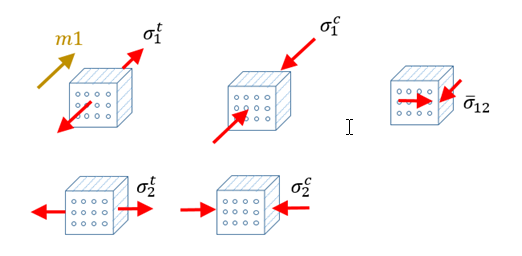/FAIL/HOFFMAN
Block Format Keyword Hoffman failure criterion for modeling the failure of composite materials. This criterion is available for solids and shells.
Format
| (1) | (2) | (3) | (4) | (5) | (6) | (7) | (8) | (9) | (10) |
|---|---|---|---|---|---|---|---|---|---|
| /FAIL/HOFFMAN/mat_ID/unit_ID | |||||||||
| Fcut | Ifail_sh | Ifail_so | |||||||
| (1) | (2) | (3) | (4) | (5) | (6) | (7) | (8) | (9) | (10) |
|---|---|---|---|---|---|---|---|---|---|
| fail_ID |
Definition
| Field | Contents | SI Unit Example |
|---|---|---|
| mat_ID | Material identifier. (Integer, maximum 10 digits) |
|
| unit_ID | (Optional) Unit
identifier. (Integer, maximum 10 digits) |
|
| Longitudinal tensile
strength. Default = 1020 (Real) |
||
| Transverse tensile
strength. Default = 1020 (Real) |
||
| Longitudinal compressive
strength. Default = 1020 (Real) |
||
| Transverse compressive
strength. Default = 1020 (Real) |
||
| Shear strength. Default = 1020 (Real) |
||
| Dynamic time relaxation. 5 Default = 1020 (Real) |
||
| Fcut | Shell tensor filtering
frequency. Default = 0.0 (Real) |
|
| Ifail_sh | Shell failure model flag.
(Integer) |
|
| Ifail_so | Solid failure model flag.
(Integer) |
|
| fail_ID | (Optional) Failure criteria
identifier. 4 (Integer, maximum 10 digits) |
Example
/UNIT/1
kg mm ms
/FAIL/HOFFMAN/1/1
# SIGMA_1T SIGMA_2T SIGMA_1C SIGMA_2C SIGMA_12
0.6 0.525 0.8 0.75 0.075
# TAU_MAX FCUT IFAIL_SH IFAIL_SO
0.005932 2 2Comments
- This failure model is available for shells and solids. It considers
a composite material ply with the fibers oriented in the direction 1 (also
denoted m1) and the matrix oriented in transverse direction, that is, in
direction 2 (and 3 for solids). Each direction considers a critical strength
value in tension and compression as;
 Figure 1.
Figure 1. Where, , , , , are respectively the critical strength in tension for direction 1, in tension for direction 2, in compression for direction 1, in compression for direction 2 and in shear.
- The failure criterion for shells is written as:
(1) For solids the criterion becomes:(2) The criterion is considered to be reached when . In fact, the damage variable corresponds to the criterion itself .
- Once the criterion is reached
, two behaviors can be set up:
- If Ifail_sh = 0 or Ifail_so = 0, there is no stress softening and elements are never deleted. In this case, the failure criterion is purely visual using the output of the damage variable.
- If Ifail_sh ≠
0 or
Ifail_so ≠
0, a stress relaxation is generated to decrease
the load carrying capacity of the element.
(3) With and .
Where,- Time.
- Start time of relaxation when the damage criteria is assumed.
- Time of dynamic relaxation.
- Stress tensor when the criterion is reached.
When the stresses reach 1% of the stress value at the beginning of the failure, the element is deleted. This is necessary to avoid instabilities coming from a sudden deletion of an element and a failure “chain reaction” in the neighboring elements. Even if the failure criterion is reached, there will be no element deletion with the default value of . Therefore, it is recommended to define a value for 10 times larger than the simulation time step.
- To avoid “chain reaction”
when deleting elements, you can also define a stress tensor filtering
frequency Fcut. Thus, the stress tensor used to calculate the HOFFMAN criterion is first
be filtered according to:
(4) With
Where, is the current timestep.
If a filtering frequency is not defined (Fcut= 0.0), the filtering effect is deactivated.
- The fail_ID is used with /STATE/BRICK/FAIL and /INIBRI/FAIL. There is no default value. If the line is blank, no value will be output for failure model variables in the /INIBRI/FAIL (written in .sta file with /STATE/BRICK/FAIL option).